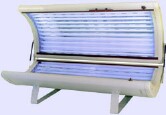
WEDNESDAY, June 20 (HealthDay News) — Young people who use tanning beds rationalize the risky behavior with statements like “everything causes cancer these days,” a new study finds.
Almost 40 percent of more than 500 U.S. college students surveyed said they use tanning beds even though they’re aware of the cancer risks associated with ultraviolet (UV) light exposure. And most do it because they want to look more attractive, found the researchers from Memorial Sloan-Kettering Cancer Center in New York City.
“It is really like weighing the risks and benefits,” said study author Smita Banerjee, an assistant attending behavioral scientist at Sloan-Kettering. The students “said there are risks in everything you do, but they are really motivated by appearance enhancement reasons.”
Hoping to find out how young adults rationalize tanning bed use, Banerjee’s team focused on questionnaires filled out by 218 students, average age 20, who frequented tanning salons. More than three-quarters were white, and 88 percent were women.
The questions were adapted from studies designed to understand why people smoke. Students could agree or disagree with explanations such as “tanning bed use is no more risky than lots of other things people do.”
The most common reasons for indoor tanning included: “everything causes cancer these days” (59 percent); tanning beds are “no more risky than lots of other things people do” (54 percent); and “it is dangerous to walk across the street” (53 percent). About 48 percent thought they didn’t use tanning beds enough to put their health at risk.
The findings are reported in a research letter in the June issue Archives of Dermatology.
Tanning beds use ultraviolet light, a known carcinogen, often at strengths 10 to 15 times stronger than summer midday exposure, according to an investigative report prepared for the House Committee on Energy and Commerce earlier this year.
They first came into use in the 1970s, and by 2007, about 27 percent of Americans, mostly women, said they used them, the congressional report said. Most users start as teenagers, Banerjee noted.
The World Health Organization lists tanning beds as a dangerous form of cancer-causing radiation, noting that use before age 30 raises the risk of melanoma, the deadliest skin cancer, by 75 percent.
In the United States, non-melanoma skin cancer strikes about 2 million people a year, with 50 percent to 90 percent of all cases resulting from UV radiation, according to WHO. It is the second most common type of cancer for people aged 15 to 29, Banerjee said.
In addition, about 75,000 new cases of melanoma are expected in 2012, accounting for about three-quarters of the 12,000 anticipated skin cancer-related deaths. However, most forms of the disease can be successfully treated if caught early.
Commenting on the study, one expert praised the researchers’ approach. “They’re definitely onto something,” said DeAnn Lazovich, an associate professor for the division of epidemiology and community health at the University of Minnesota, Minneapolis.
“They’re looking at a set of attitudes that might be related to the use of tanning beds, so it’s novel from that standpoint,” Lazovich said, adding it could help to understand why people engage in this risky behavior.
The tanning bed industry’s regulation by the U.S. Food and Drug Administration seems to have “unintended consequences,” Lazovich said. Laws intended to protect people can also create the perception that something is safe, she said.
Almost 32 percent of study respondents agreed with the statement that “if tanning bed use was so bad for you, the government would ban tanning beds.”
Hoping to deter indoor tanning, the 2010 health care law imposed a 10 percent tax on tanning beds, and many states restrict or ban their use by minors.
The authors noted some limitations to their work, including the small sample size, and said more research is needed to fully understand the desire to tan indoors.
More information
To learn how to prevent skin cancer, visit the U.S. National Cancer Institute.

